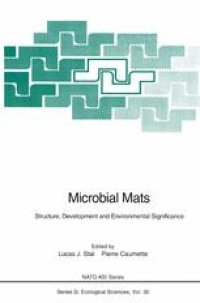
Ebook: Microbial Mats: Structure, Development and Environmental Significance
- Tags: Sedimentology, Microbiology, Mineralogy, Biotechnology, Cell Biology, Biochemistry general
- Series: NATO ASI Series 35
- Year: 1994
- Publisher: Springer-Verlag Berlin Heidelberg
- Edition: 1
- Language: English
- pdf
Microbial mats are benthic communities of a variety of microorganisms. Their investigation requires multidisciplinary studies and close cooperation between microbiologists, biogeochemists, and geologists.
Reported here are recent advances in the study of structure, development and ecological relationships. The methodology described includes microsensors as well as new molecular techniques for the detection and identification of microorganisms. Increasing interest exists for applied aspects, e.g. the possibility to use natural or constructed microbial mats for the degradation of xenobiotics, for site remediation, etc.
Microbial mats are benthic communities of a variety of microorganisms. Their investigation requires multidisciplinary studies and close cooperation between microbiologists, biogeochemists, and geologists.
Reported here are recent advances in the study of structure, development and ecological relationships. The methodology described includes microsensors as well as new molecular techniques for the detection and identification of microorganisms. Increasing interest exists for applied aspects, e.g. the possibility to use natural or constructed microbial mats for the degradation of xenobiotics, for site remediation, etc.
Microbial mats are benthic communities of a variety of microorganisms. Their investigation requires multidisciplinary studies and close cooperation between microbiologists, biogeochemists, and geologists.
Reported here are recent advances in the study of structure, development and ecological relationships. The methodology described includes microsensors as well as new molecular techniques for the detection and identification of microorganisms. Increasing interest exists for applied aspects, e.g. the possibility to use natural or constructed microbial mats for the degradation of xenobiotics, for site remediation, etc.
Content:
Front Matter....Pages I-XVIII
Front Matter....Pages 1-1
Microbial mat research: The recent past and new perspectives....Pages 3-18
Front Matter....Pages 19-19
Microbial mats in coastal environments....Pages 21-32
Species diversity in hot spring microbial mats as revealed by both molecular and enrichment culture approaches — relationship between biodiversity and community structure....Pages 33-44
Microbial mats in a thermomineral sulfurous cave....Pages 45-50
Establishment of phototrophic purple sulphur bacteria in microbial mat systems....Pages 51-60
Biological versus inorganic processes in stromatolite morphogenesis: Observations from mineralizing sedimentary systems....Pages 61-68
Morphological and chemical transformations of Microcoleus chthonoplastes during early diagenesis in hypersaline microbial mats....Pages 69-76
On the significance of solar ultraviolet radiation for the ecology of microbial mats....Pages 77-84
Environmental factors controlling the development of microbial mats in inland saline lakes; the granulometric composition of the sediment....Pages 85-90
Structure of the sediment at depositional saline environments....Pages 91-96
Microbiological mediation of sediment structure and behaviour....Pages 97-109
Field and cultivated Microcoleus chthonoplastes: The search for clues to its prevalence in marine microbial mats....Pages 111-116
The sensitivity for salinity increase in the drought resistant cyanobacterium Crinalium epipsammum SAB 22.89....Pages 117-123
Osmotic adaptation of microbial communities in hypersaline microbial mats....Pages 125-130
Back Matter....Pages 131-132
Front Matter....Pages 133-133
Analysis of microbial mats by use of electrochemical microsensors: Recent advances....Pages 135-147
Optical properties of microbial mats: Light measurements with fiber-optic microprobes....Pages 149-166
Gas diffusion probe for measurement of CH4 gradients....Pages 167-172
Light and electron microscopy in microbial mat research: An overview....Pages 173-182
Motility of Microcoleus chthonoplastes subjected to different light intensities quantified by digital image analysis....Pages 183-191
Application of molecular genetics to the study of microbial communities....Pages 193-206
Back Matter....Pages 235-240
Front Matter....Pages 133-133
Determination of the genetic diversity of microbial communities using DGGE analysis of PCR-amplified 16S rDNA....Pages 207-214
Exopolymers in microbial mats: Assessing their adaptive roles....Pages 215-219
The challenge to analyse extracellular polymers in biofilms....Pages 221-227
New cultivation techniques and laboratory model systems for investigating the growth of stratified microbial communities....Pages 229-234
Back Matter....Pages 235-240
Front Matter....Pages 241-241
Diffusion processes and boundary layers in microbial mats....Pages 243-253
Cycling of carbon, sulfur, oxygen and nutrients in a microbial mat....Pages 255-263
Nitrogen cycling in microbial mat communities: The quantitative importance of N-fixation and other sources of N for primary productivity....Pages 265-271
Production and consumption of volatile organosulfur compounds in microbial mats....Pages 273-278
Back Matter....Pages 279-284
Front Matter....Pages 285-286
The carbon isotope biogeochemistry of microbial mats....Pages 287-287
The fluxes of inorganic carbon and CO2-dependent genes involved in the cyanobacterial inorganic carbon-concentrating mechanism: A view on some of the open questions....Pages 289-298
Oxygenic photosynthesis and light distribution in marine microbial mats....Pages 299-304
The effects of irradiance, temperature and desiccation on cyanobacterial photosynthesis: A possible explanation for the diurnal changes in surface waterblooms....Pages 305-310
Denitrification, nitrification and nitrogen assimilation in photosynthetic microbial mats....Pages 311-318
Nitrogen fixation dynamics in microbial mats....Pages 319-324
Relationships between functional groups of organisms in microbial mats....Pages 325-337
Diel and spatial fluctuations of sulfur transformations....Pages 339-352
Back Matter....Pages 353-359
Front Matter....Pages 361-364
Novel metabolic capacities of sulfate-reducing bacteria, and their activities in microbial mats....Pages 365-365
Diversity of and interactions among sulphur bacteria in microbial mats....Pages 367-376
Phototrophic oxidation of ferrous minerals — a new aspect in the redox microbiology of iron....Pages 377-392
Back Matter....Pages 393-402
Front Matter....Pages 429-432
Heterocystous versus non-heterocystous cyanobacteria in microbial mats....Pages 365-365
Development of versicolored microbial mats: Succession of microbial communities....Pages 403-414
Light-driven sulfate reduction and methane emission in hypersaline cyanobacterial mats....Pages 415-420
Back Matter....Pages 421-427
Front Matter....Pages 429-432
Bioremediability and biological value of microbial mats....Pages 433-433
New concepts in biogeochemical cycling and ecology....Pages 435-436
Front Matter....Pages 437-440
Cyanobacterial mats in general biology....Pages 441-441
Back Matter....Pages 443-452
....Pages 453-466
Download the book Microbial Mats: Structure, Development and Environmental Significance for free or read online
Continue reading on any device:

Last viewed books
Related books
{related-news}
Comments (0)